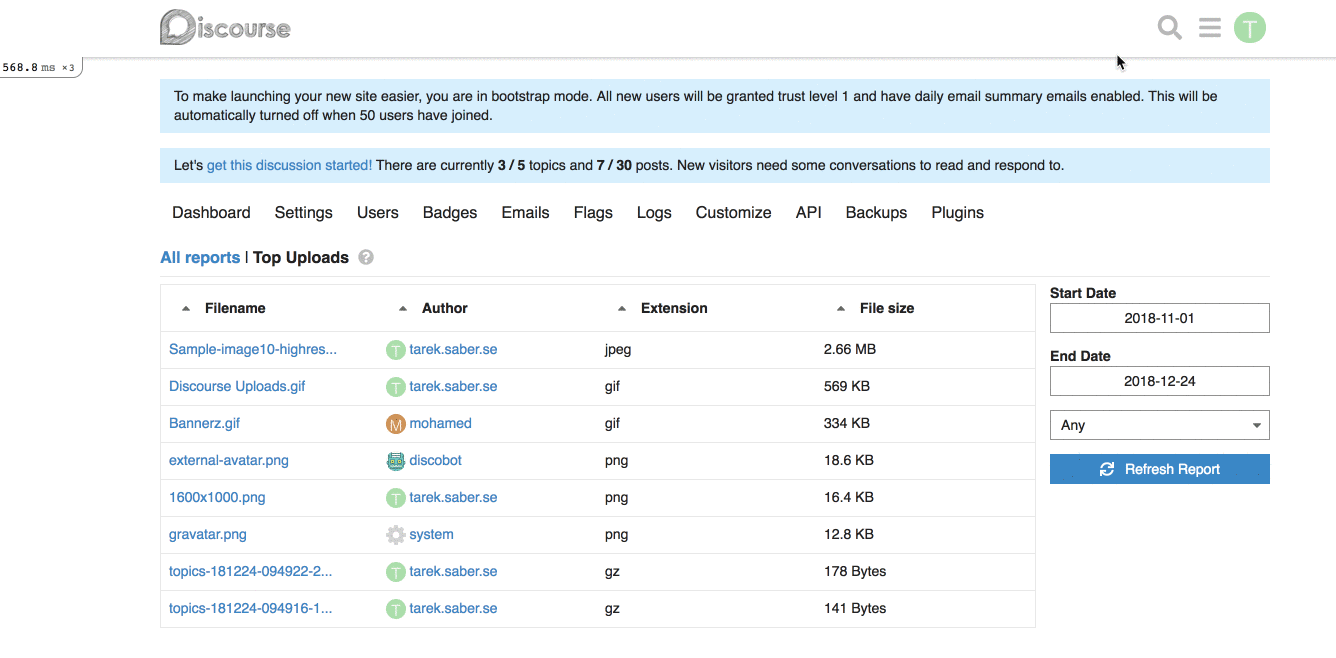Fixes two issues:
1. Redirecting to an external origin's path after login did not work
2. User would be erroneously redirected to the external origin after logout
https://meta.discourse.org/t/109755
This refactor addresses the following issues:
1- Moves all relevant logic to the discourse-topic component (matches desktop)
2- Fixes the flicker issue discussed here
3- Fixes a rare occurring issue where tags wrap to a third line if a topic has long category names and lots of tags
4- Fixes header icon jitter on iOS
5- Fixes an issue where sliding out user / hamburger menus on Android leaves the user in a mid-state with half a title and the header panel visible - swiping will now open the menus but have no effect on the header.
6- adds min-width to the small-logo to act as placeholder so that the title doesn't shift if the logo takes a while to load.
Other than that, everything should look and act the same.
* This is causing certain posts to appear in searches incorrectly as `PostSearchData#raw_data` contains the outdated title, category name and tag names.
* Remove use of 0 in favor of `TrustLevel.levels[:newuser]`.
* Consolidate two tests into a single one.
* Test that disabling the feature works.
* Avoid loading full ActiveRecord object in test when we only need to
know the existence of the record.
This reverts commit d1c4981f65.
Per discussion with @coding-horror it was decided this change is to
far reaching.
Instead we will make smaller strategic changes to tooltips that add
value.
This will allow users installing a Discourse PWA to use their active
theme colors on the generated app. Thanks for @mgiuca for the tip.
Also makes the share_target config explicit to silence Chrome warnings
* improved emoji support
- always optimize images as part of the task
- use the unicode standard ordering/naming for sections
* UX: more height for when there are recently used
Migrates email user options to a new data structure, where `email_always`, `email_direct` and `email_private_messages` are replace by
* `email_messages_level`, with options: `always`, `only_when_away` and `never` (defaults to `always`)
* `email_level`, with options: `always`, `only_when_away` and `never` (defaults to `only_when_away`)
* FEATURE: Exposing a way to add a generic report filter
## Why do we need this change?
Part of the work discussed [here](https://meta.discourse.org/t/gain-understanding-of-file-uploads-usage/104994), and implemented a first spike [here](https://github.com/discourse/discourse/pull/6809), I am trying to expose a single generic filter selector per report.
## How does this work?
We basically expose a simple, single generic filter that is computed and displayed based on backend values passed into the report.
This would be a simple contract between the frontend and the backend.
**Backend changes:** we simply need to return a list of dropdown / select options, and enable the report's newly introduced `custom_filtering` property.
For example, for our [Top Uploads](https://github.com/discourse/discourse/pull/6809/files#diff-3f97cbb8726f3310e0b0c386dbe89e22R1423) report, it can look like this on the backend:
```ruby
report.custom_filtering = true
report.custom_filter_options = [{ id: "any", name: "Any" }, { id: "jpg", name: "JPEG" } ]
```
In our javascript report HTTP call, it will look like:
```js
{
"custom_filtering": true,
"custom_filter_options": [
{
"id": "any",
"name": "Any"
},
{
"id": "jpg",
"name": "JPG"
}
]
}
```
**Frontend changes:** We introduced a generic `filter` param and a `combo-box` which hooks up into the existing framework for fetching a report.
This works alright, with the limitation of being a single custom filter per report. If we wanted to add, for an instance a `filesize filter`, this will not work for us. _I went through with this approach because it is hard to predict and build abstractions for requirements or problems we don't have yet, or might not have._
## How does it look like?

## More on the bigger picture
The major concern here I have is the solution I introduced might serve the `think small` version of the reporting work, but I don't think it serves the `think big`, I will try to shed some light into why.
Within the current design, It is hard to maintain QueryParams for dynamically generated params (based on the idea of introducing more than one custom filter per report).
To allow ourselves to have more than one generic filter, we will need to:
a. Use the Route's model to retrieve the report's payload (we are now dependent on changes of the QueryParams via computed properties)
b. After retrieving the payload, we can use the `setupController` to define our dynamic QueryParams based on the custom filters definitions we received from the backend
c. Load a custom filter specific Ember component based on the definitions we received from the backend